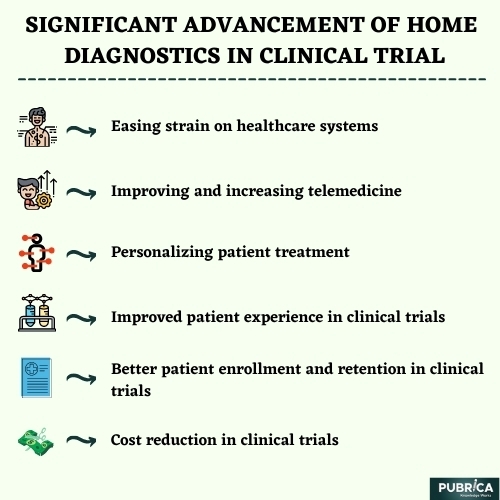
The benefits of R programming in clinical trial data analysis
January 19, 2021
Systematic Review of Machine Learning in the Pharmaceutical Industry
January 25, 2021In Brief
- Research services in which people, or data or samples of tissue from people, are studied to understand health and disease. Clinical research services help find new and better ways to detect, diagnose, treat, and prevent disease.
- Types of clinical research include clinical trials, which test new treatments for a disease, and natural history studies, which collect health information to understand how a disease develops and progresses over time.
Introduction
In the past few decades, the field of home diagnostics has seen considerable advancement and development. The increasing use of home testing has allowed significant clinical research to proceed remotely in the aftermath of the COVID-19 pandemic.
The advantages of clinical development services implementing remote study protocols are essential, indicating that the changes introduced in reaction to COVID-19 are a more considerable step towards decentralizing experiments and clinical research. Home diagnostics will play a significant role in how clinical practice advances, as physicians gradually accept interactive resources and remote monitoring.
The growth of home diagnostics in a clinical trial
Home diagnostics has a diverse history; the research has grown considerably clinical writing services since the first at-home fertility tests became available in the 1970s to give patients responsive monitoring in the comfort of their own homes. Intimate treatments such as sexually transmitted disease testing have been eligible for at-home HIV screening since 1996. Commercial home diagnostics has grown to include DNA and genealogical tests and cover the health industry by providing aggressive fertility, organ function, and more research to customers.
Home diagnostic tools include the opportunity for doctors to capture critical data points remotely. Blood pressure, respiratory monitoring, dermatological diagnosis, and neurological testing provide clinical results obtained by home testing. Besides, highly personalized home collection kits allow patients to gather and send directly for laboratory testing their biological samples, removing the need for clinicians to manage the preparation, packaging, and shipping of samples
As CRO Services adopts remote testing and patient monitoring as standard protocol, the clinical trial landscape will need to adjust to seeing trials and successful research outcomes.
Significant advancement of home diagnostics in the clinical trial
The advantages of home diagnostics for clinicians and health care practitioners (HCPs) alike, home diagnostics offers a host of benefits:
- Easing strain on healthcare systems – home testing and monitoring becomes more convenient, quicker, and more precise. It will relieve pressure on HCPs to manage heavy workloads, particularly when it comes to regular testing and patient monitoring.
- Improving and increasing telemedicine – many medical visits are now carried out over the internet or video call. Home diagnostics allow HCPs to directly order examinations, eliminating clinics and hospitals’ requirement to be accessed by patients.
- Personalizing patient treatment– home diagnostics increases the capacity of physicians to deliver quicker and better-targeted medical care and provides patients with a more open and tailored approach to handling their own individual health care.
- Improved patient experience in clinical trials – home testing can eliminate the need for time-consuming site visits, reducing the burden on patients who may be either too busy to miss work for appointments, or too unwell to leave home for travel.
- Better patient enrollment and retention in clinical trials – making the trial process easier on participants increases patient enrollment and retention, reducing the commercial impact associated with patients dropping out of trials

- Cost reduction in clinical trials – with fewer and smaller clinical sites required, it becomes more comfortable and less costly for tests to scale-up studies for larger regions and bigger patient pools.
Logistical challenges for clinical researchers
The logistics of implementing at-home testing involve several critical considerations for clinical medicine research and trial service providers alike, including:
- Clinical sample monitoring and tracing- Trial sample kits must be correctly labelled and assembled to maintain the dignity of clinical samples, with specific guidelines for use and electronic tracking to minimize the possibility of human error.
- Data and privacy issues – must be closely handled during the shipping, processing, and handling of all medical samples and data to ensure patient privacy and data protection, marking and indexing, to correctly document the source of those samples, if necessary, or to anonymize or blind examples in some situations.
Home diagnostics meant for clinical trials
The home diagnostics area can ease the transition from conventional models of on-site clinical testing to a digital system that improves health technology. In tandem with the increased use of mHealth technologies such as wearables and mobile applications and telemedicine adoption, home diagnostics can play a critical role in allowing trial protocols to move towards a decentralized approach.
With significant clinical advantages to be achieved using home diagnostics, mainly because COVID-19 demands a remote approach to clinical research, clinical trial managers and clinical service providers must work together to manage the trial landscapes’ rapidly evolving needs. At Clinical services, in a COVID-19-related report, we were able to move quickly to determine the tools available for at-home research better and expedite the provision of kits for gathering at-home patient samples. In adapting home research to the changing demands of clinical trials in the future, certain forms of approaches would be critical.
Conclusion
In light of global health issues, as the area of clinical science reacts to evolving conditions, home diagnostics is one of several resources that can promote remote clinical research paper writing services, but it is an important one. The reduction or removal of the requirement for on-site visits would increase patient enrollment and retention and decrease clinical studies’ expense, enabling trials to progress quickly and efficiently, and ultimately get important treatments to market faster.
References
- Erin Blakemore. This Is What the First Home Pregnancy Test Looked Like. June 2015. Accessed May 2020.
- Mobolaji Ibitoye, Timothy Frasca, Rebecca Giguere, and Alex Carballo-Diéguez. Home Testing Past, Present and Future: Lessons Learned and Implications for HIV Home Tests (A Review). May 2014. Accessed June 2020.
- Global Home Diagnostics Market is Expected to Reach USD 6.53 Billion by 2025: . Fior Markets. August 2019. Accessed May 2020.
